Introduction
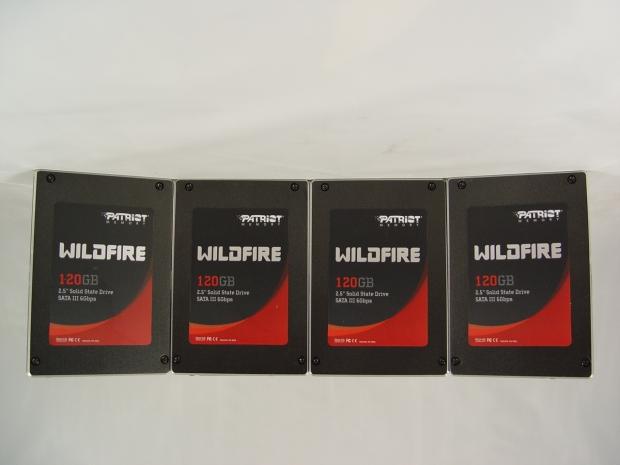
We first saw the Patriot Wildfire back in June of 2011 and at the time it was one of the hottest new SSDs on the market. That was around 9 months ago so while no longer new, Wildfire is still competitive with, and considered one of the best on the market today. The key to Wildfire's longevity is the Toshiba Toggle Mode flash Patriot chose to use on this SSD.
Toshiba and their partner SanDisk has received a lot of press lately for their new 24nm Toggle Mode flash. The new 24nm flash has proven to be very fast, but that is about the only thing it's proved so far. We're still seeing issues in our labs with write performance degrading rapidly until TRIM finishes its cycle. This was not a problem on the older 32nm Toggle Mode flash, the same used on the Patriot Wildfire.
For most consumer users the issues we're seeing with 24nm Toggle Mode flash aren't going to be a big issue because the TRIM cycle is fairly quick. I've heard the WHQL spec for TRIM is around 70ms, but we've found that isn't always the case. In RAID we are still waiting for Microsoft and Intel to get their ducks in a row, so using 24nm Toggle Mode flash isn't ideal at this time. Older 32nm Toggle Mode flash is still the best choice for RAID. Given that Patriot has already announced their Wildfire SE (Second Edition) with 24nm Toggle Mode flash and a Wildfire PRO model with more space allocated to background and performance improving functions we're going to say that others have already noticed what we have with the new 24nm flash and RAID.
So even with new flash right around the corner the old flash may be a better option today for your high performance RAID needs. Today we are going to put that to the test and rock the block with some RAID performance featuring the Patriot Wildfire 128GB drives. To spice thing up we are running dual drive RAID 0 on the built in Intel RAID and 4 drive RAID 5 with the awesome LSI 9265-8i.
Specifications, Pricing and Availability
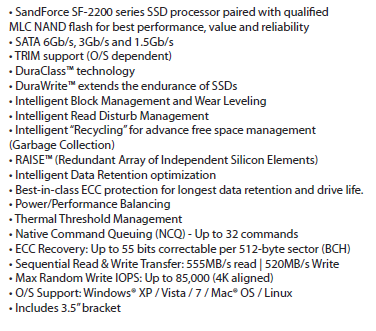
Before we start our Toggle Mode RAID adventure let's recap the Patriot Wildfire.
Based on the no compromise SandForce SF-2281 controller, the Patriot Wildfire is a take no prisoners, kick ass SSD. When we first reviewed the 120GB model last June SandForce didn't have the optimizations they do now yet our Wildfire didn't give us any issues in the lab or in our gaming computer.
I rarely talk about what components I use, but since we are looking at it today I'll let you know that I've been using Wildfire RAID for a while.
Patriot released three capacity sizes and they are available at Newegg today. The sizes are 120GB, 240GB and a massive 480GB. The 120GB model we are looking at today is priced at 174.99 at the time of writing.
At this price you are getting real premium flash that is starting to become rare and the highest performing controller on the market today.
Packaging and Drives
Packaging
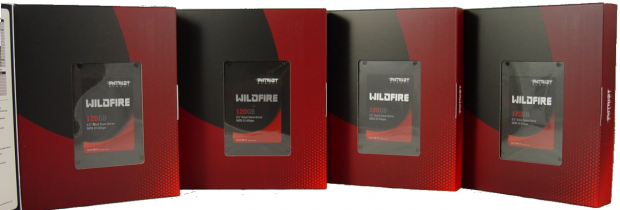
We're going to skim over some of these images to recap the physical side of Wildfire.
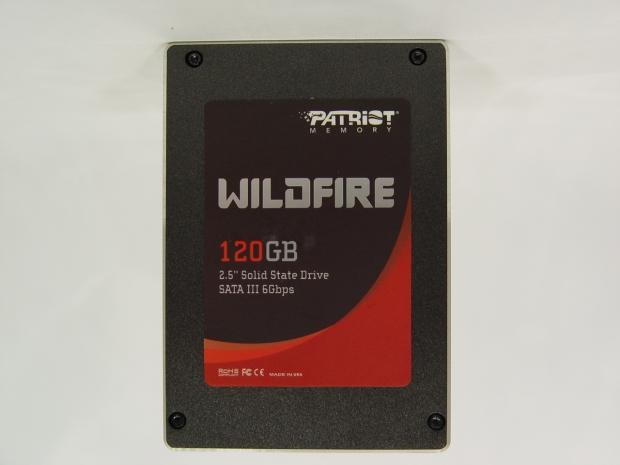
2.5" form factor with a 9mm z-height, notebook and desktop capable.
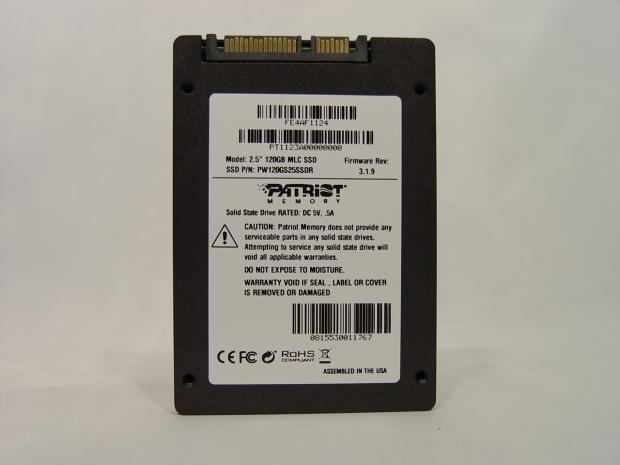
Wildfire is well sorted with all of the mounting locations where they should be.
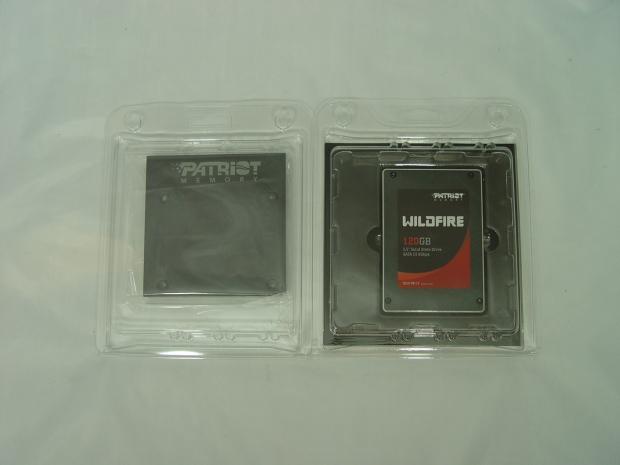
Patriot includes a desktop adapter bracket. This accessory is no longer a given these days. Many of the newer model SSDs we've seen do not ship with an adapter bracket.
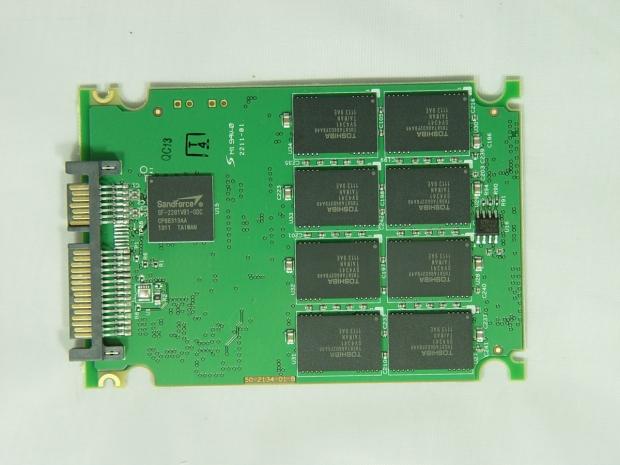
Patriot laid out a clean design on the PCB. Here we see the SandForce SF-2281 controller and eight of the sixteen 32nmToshiba Toggle Mode flash chips.
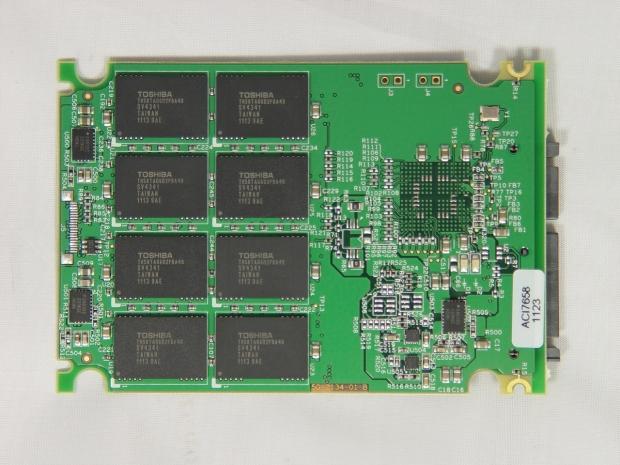
The surface mount resistors and capacitors are all located on the underside of the PCB. Here we see the remaining eight flash chips.
Benchmarks - Test System Setup and ATTO Baseline Performance
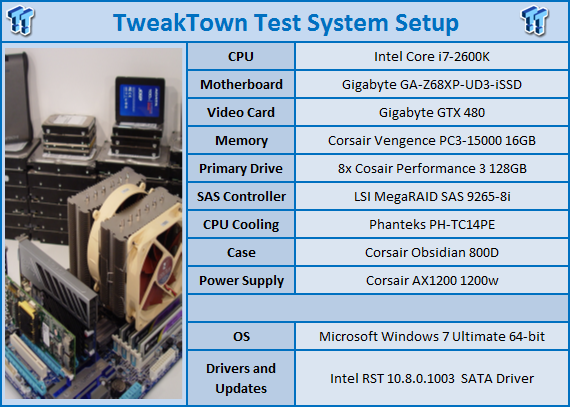
We would like to thank the following companies for supplying and supporting us with our test system hardware and equipment: AVADirect, GIGABYTE, Cooler Master, LSI, Corsair and Noctua.
You can read more about TweakTown's Storage Product Testing Workstation and the procedures followed to test products in this article.
ATTO Baseline Performance
Version and / or Patch Used: 2.34
ATTO is used by many disk manufacturers to determine the read and write speeds that will be presented to customers.
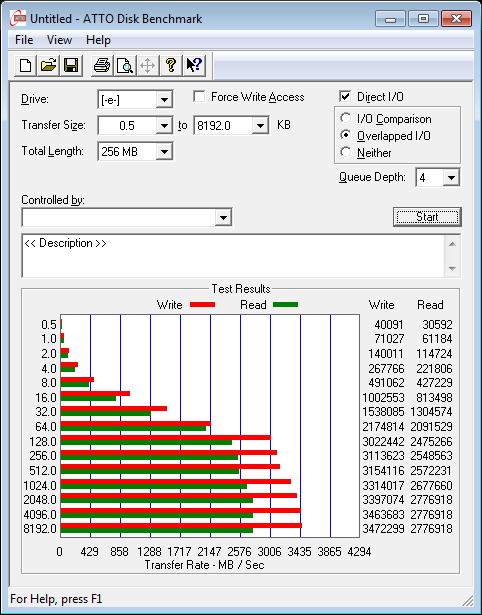
Sometimes I just can't help myself. When you are using 4 drives and linking them in RAID it's best to use RAID 5, but what fun is being safe. Here we see four Patriot Wildfire 120GB drives running RAID 0 on an LSI 9565-8i controller with Fast Path enabled. We almost hit 3,500MB/s write speed on this array and the 2,777MB/s read speed isn't too shabby either.
Benchmarks - HD Tune Pro
HD Tune Pro
Version and / or Patch Used: 4.00
Developer Homepage: http://www.efdsoftware.com
Product Homepage: http://www.hdtune.com
HD Tune is a Hard Disk utility which has the following functions:
Benchmark: measures the performance
Info: shows detailed information
Health: checks the health status by using SMART
Error Scan: scans the surface for errors
Temperature display
HD Tune Pro gives us accurate read, write and access time results and for the last couple of years has been gaining popularity amongst reviewers. It is now considered a must have application for storage device testing.
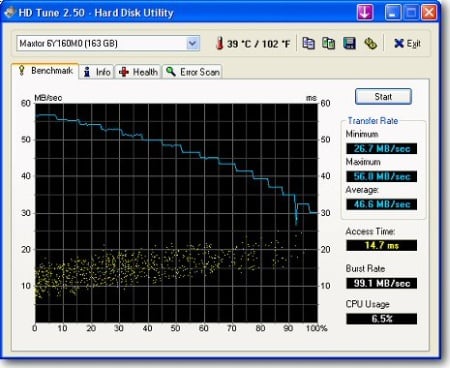
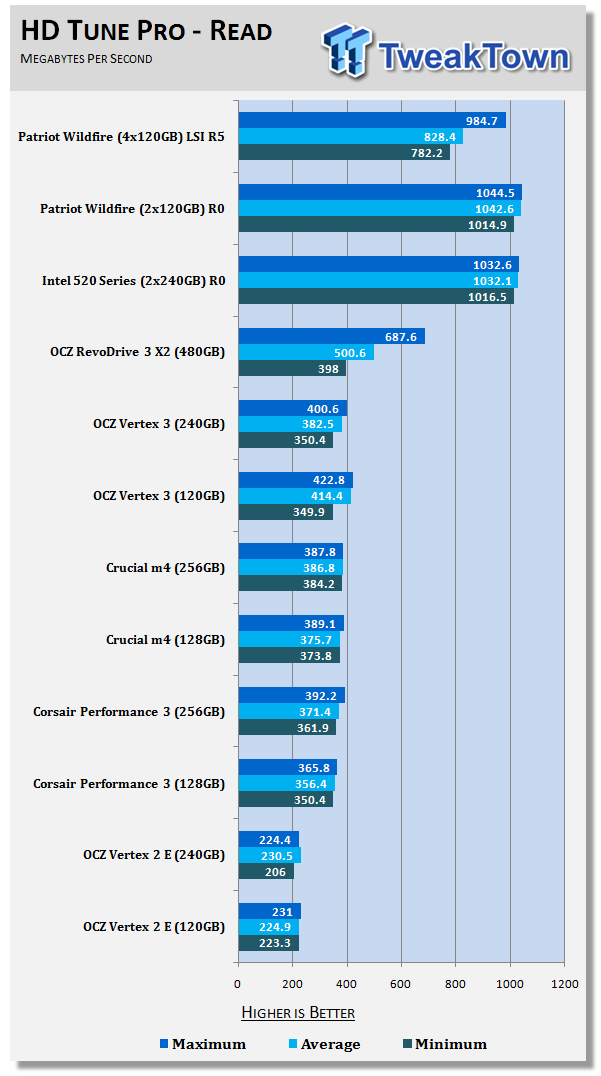
Oh what I wouldn't give for RAID TRIM right now. The Patriot Wildfire drives are so fast, but keeping them that way can be difficult. Here we see the RAID 5 array already running at steady state, that is when every new write needs to go through the read, erase then write cycle. Our enterprise readers have asked to see the RAID 5 numbers this way and we obliged.
For the enthusiast we have the two drive RAID 0 numbers with two drives running on Intel's native SATA 6G.
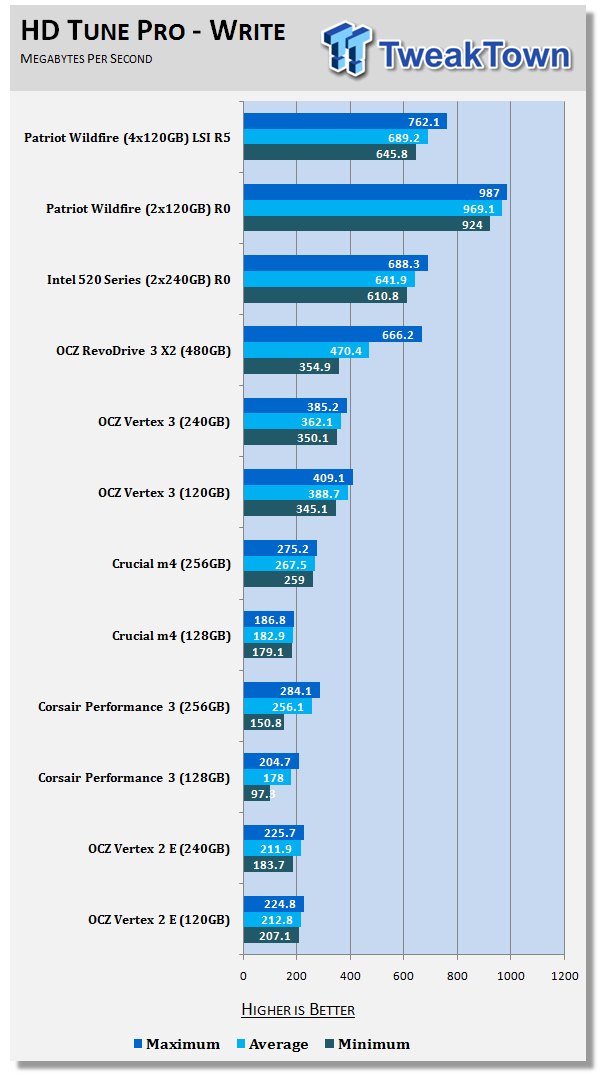
We've discussed the write limitations of the 120GB SandForce drives before. When compared to the 240GB drives the single drive 120GB setup hits a brick wall when writing data.
Benchmarks - AIDA64 Random Access Time
AIDA64 Random Access Time
Version and / or Patch Used: 1.60
Developer Homepage: http://www.aida64.com
Product Homepage: http://www.aida64.com
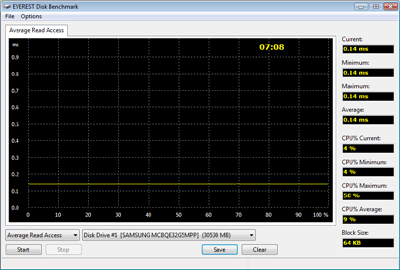
AIDA64 offers several different benchmarks for testing and optimizing your system or network. The Random Access test is one of very few if not only that will measure hard drives random access times in hundredths of milliseconds as oppose to tens of milliseconds.
Drives with only one or two tests displayed in the write test mean that they have failed the test and their Maximum and possibly their Average Scores were very high after the cached fills. This usually happens only with controllers manufactured by JMicron and Toshiba.
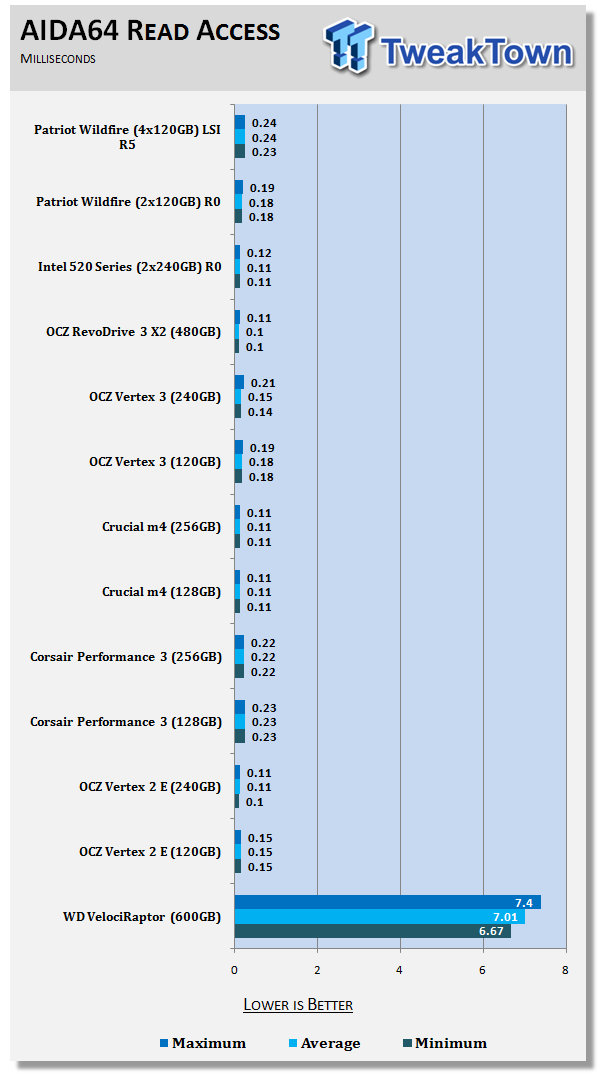
SSDs are all about access times, this is what makes them feel fast in your system and aids in making your programs and applications start quickly. Traditional spinners take a relatively long time to access data and that length of time nearly doubles by the number of drives with RAID. With SSDs, the initial value is very small so even though the read access time increases when you add more drives the increase is so small you fail to notice it.
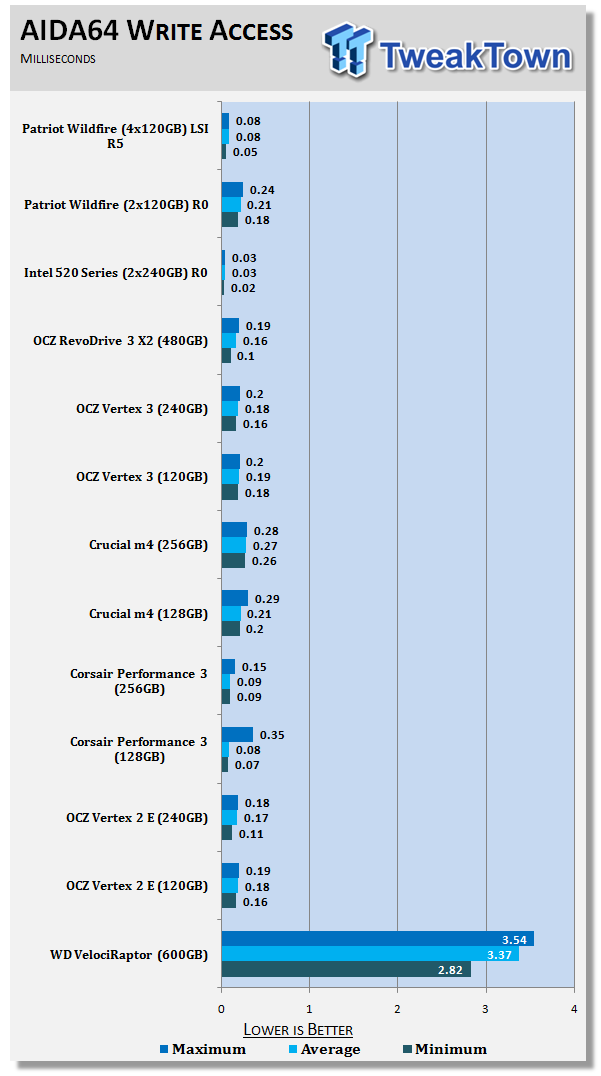
The RAID 5 array on the LSI controller makes good use of the 1GB cache when writing small 64kb size data. The Patriot Wildfire RAID 0 array on the Intel PCH still has very low access times, but a little higher than what we've recorded with some of the other drives.
Benchmarks - CrystalDiskMark
CrystalDiskMark
Version and / or Patch Used: 3.0 Technical Preview
Developer Homepage: http://crystalmark.info
Product Homepage: http://crystalmark.info/software/CrystalDiskMark/index-e.html
Download here: http://crystaldew.info/category/software/crystaldiskmark
CrystalDiskMark is a disk benchmark software that allows us to benchmark 4K and 4K queue depths with accuracy.
Key Features:-
* Sequential reads/writes
* Random 4KB/512KB reads/writes
* Text copy
* Change dialog design
* internationalization (i18n)
Note: Crystal Disk Mark 3.0 Technical Preview was used for these tests since it offers the ability to measure native command queuing at 4 and 32.
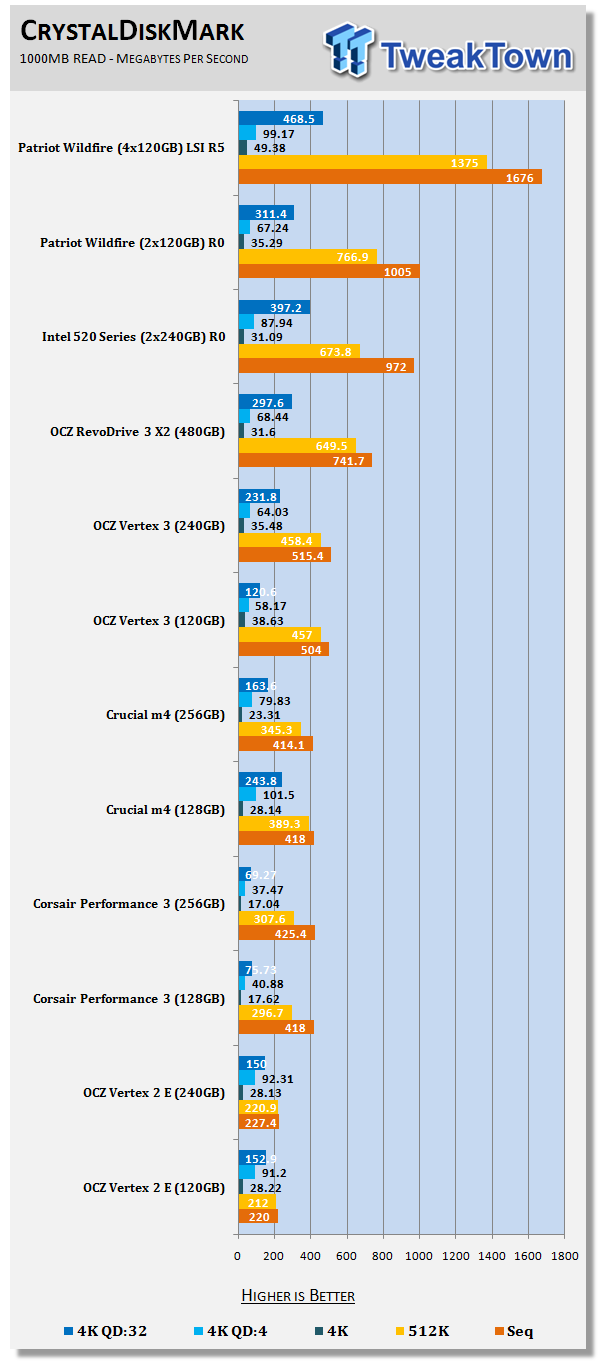
In CDM we're looking at 4k and NCQ performance. The Patriot Wildfire arrays scale when adding drives to the array as shown in the chart.
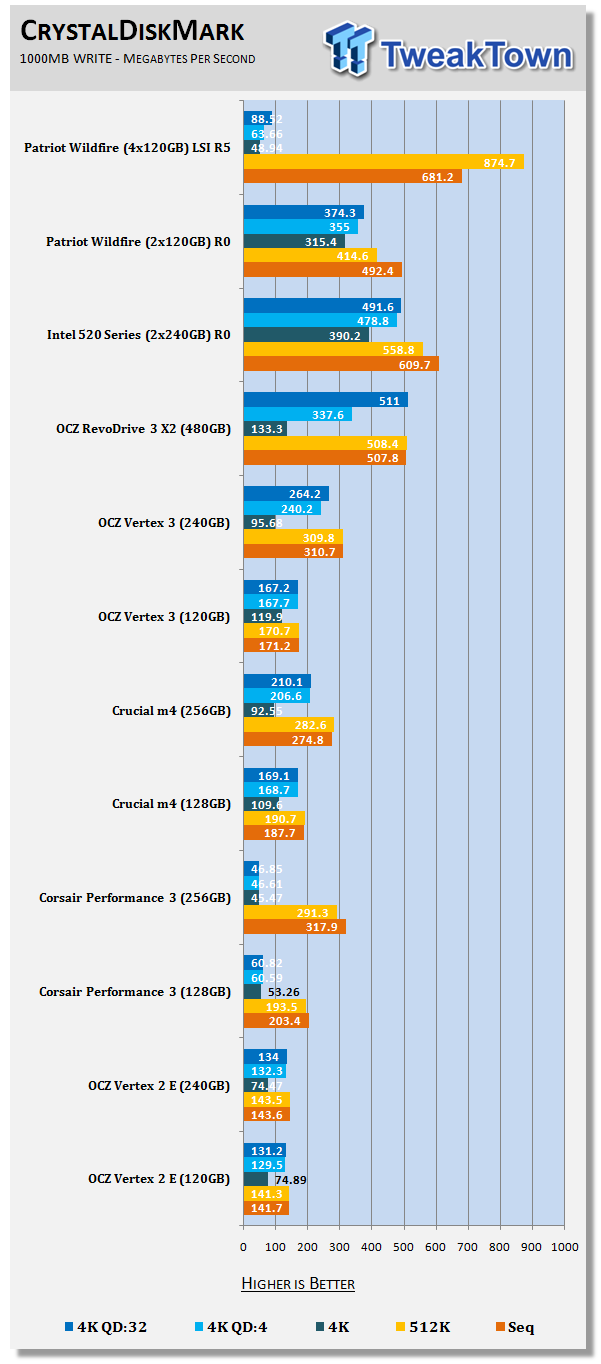
Wildfire also scales well when writing data on the Intel PCH.
This will be a good time to talk about stripe sizes on enterprise controllers. When we built our RAID 5 array we chose a stripe size of 64K, the default for the LSI 9265-8i. You can tune the controller for better random write speeds by using smaller stripe sizes. For better sequential reads and writes you can use a larger stripe size. 64 is right in the middle so our setup isn't turned for one over the other. Because of that we achieved poor 4K and NCQ results in this test.
Benchmarks - PCMark Vantage Hard Disk Tests
PCMark Vantage - Hard Disk Tests
Version and / or Patch Used: 1.0.0
Developer Homepage: http://www.futuremark.com
Product Homepage: http://www.futuremark.com/benchmarks/pcmark-vantage/
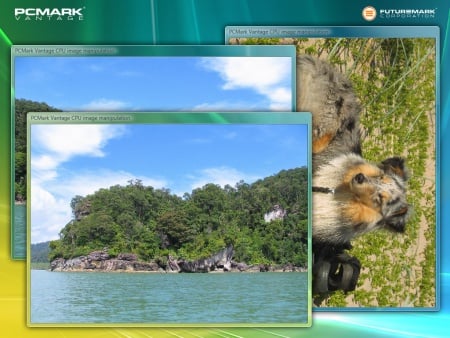
PCMark Vantage is the first objective hardware performance benchmark for PCs running 32 and 64 bit versions of Microsoft Windows Vista. PCMark Vantage is perfectly suited for benchmarking any type of Microsoft Windows Vista PC from multimedia home entertainment systems and laptops to dedicated workstations and high-end gaming rigs. Regardless of whether the benchmarker is an artist or an IT Professional, PCMark Vantage shows the user where their system soars or falls flat, and how to get the most performance possible out of their hardware. PCMark Vantage is easy enough for even the most casual enthusiast to use yet supports in-depth, professional industry grade testing.
FutureMark has developed a good set of hard disk tests for their PCMark Vantage Suite. Windows users can count on Vantage to show them how a drive will perform in normal day to day usage scenarios. For most users these are the tests that matter since many of the old hat ways to measure performance have become ineffective to measure true Windows performance.

HDD1 - Windows Defender
HDD2 - Gaming
HDD3 - Windows Photo Gallery
HDD4 - Vista Startup
HDD5 - Windows Movie Maker
HDD6 - Windows Media Center
HDD7 - Windows Media Player
HDD8 - Application Loading
Vantage is a consumer desktop benchmark that favors consumer RAID over redundant enterprise RAID. Sometimes the perks of enterprise storage are not all they are cracked up to be on the consumer side. I can tell you this though, I always get the jet in Battlefield 3 when a match starts with the RAID 5 array running the four Patriot Wildfire 120GB drives.
The RAID 0 array shows good scaling once again over a single 120GB SandForce based SSD.
Benchmarks - AS SSD
AS SSD Benchmark
Version and / or Patch Used: 1.2.3577.40358
Developer Homepage: Alex Intelligent Software
Product Homepage: Alex Intelligent Software
Download here: http://www.alex-is.de/PHP/fusion/downloads.php?cat_id=4&download_id=9
AS determines the performance of Solid State Drives (SSD). The tool contains four synthetic as well as three practice tests. The synthetic tests are to determine the sequential and random read and write performance of the SSD. These tests are carried out without the use of the operating system caches.
In all synthetic tests the test file size is 1GB. AS can also determine the access time of the SSD, the access of which the drive is determined to read through the entire capacity of the SSD (Full Stroke). The write access test is only to be met with a 1 GB big test file. At the end of the tests three values for the read and write as well as the overall performance will be issued. In addition to the calculated values which are shown in MB/s, they are also represented in IO per seconds (IOPS).
Note: AS SSD is a great benchmark for many tests, but since Crystal Disk Mark covers a broader range of 4K tests and HD Tune Pro covering sequential speeds, we will only use the Copy Benchmark from AS SSD.
- Copy Benchmark
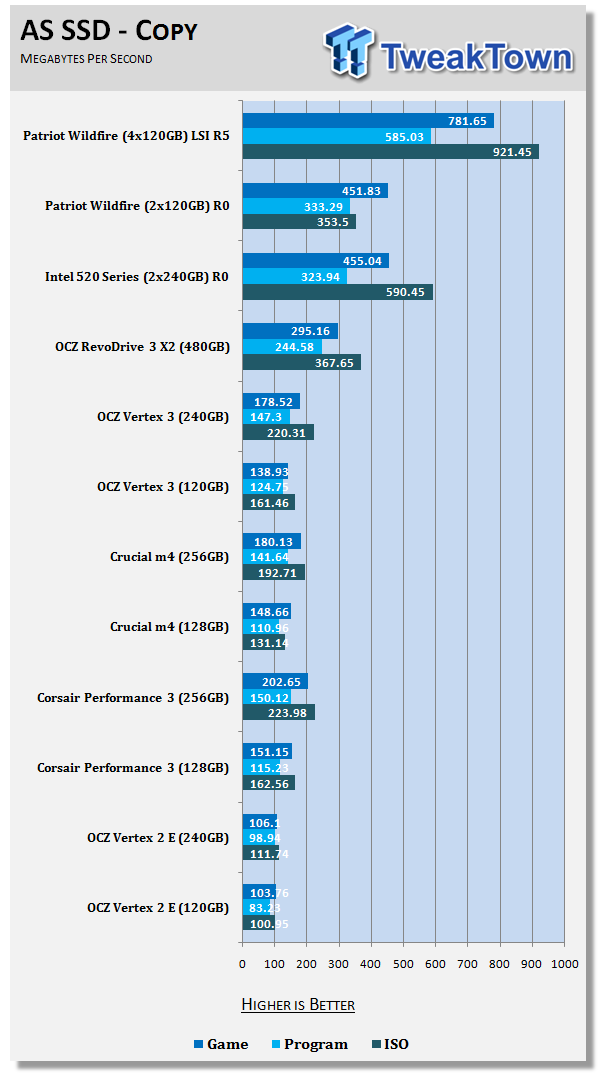
Personally, given the choice between a single 240GB SandForce SSD or two 120GB drives I'd opt for the latter every time. Here we can see why, with the dual 120GB R0 setup compared to the single OCZ 120GB Vertex 3 the file transfer performance skyrockets. The larger your drive or array the more data you will move to and from the drive and being able to double that performance is a big help in reducing your idle time waiting for the task to complete.
Benchmarks - Passmark
Passmark Advanced Multi-User Tests
Version and / or Patch Used: 6.1
Developer Homepage: http://www.passmark.com
Test Homepage: http://www.passmark.com
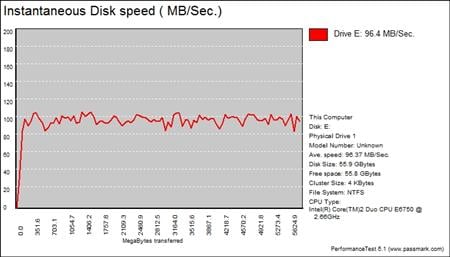
Many users complain that I/O Meter is too complicated of a benchmark to replicate results so my quest to find an alternative was started. Passmark has added several multi-user tests that measure a hard drives ability to operate in a multi-user environment.

The tests use different settings to mimic basic multi-user operations as they would play out on your server. Variances is read / write percentage as well as random / sequential reads are common in certain applications, Web Servers read nearly 100% of the time while Database Servers write a small amount of data.
The Workstation test is the only single user environment and will be similar to how you use your system at home.
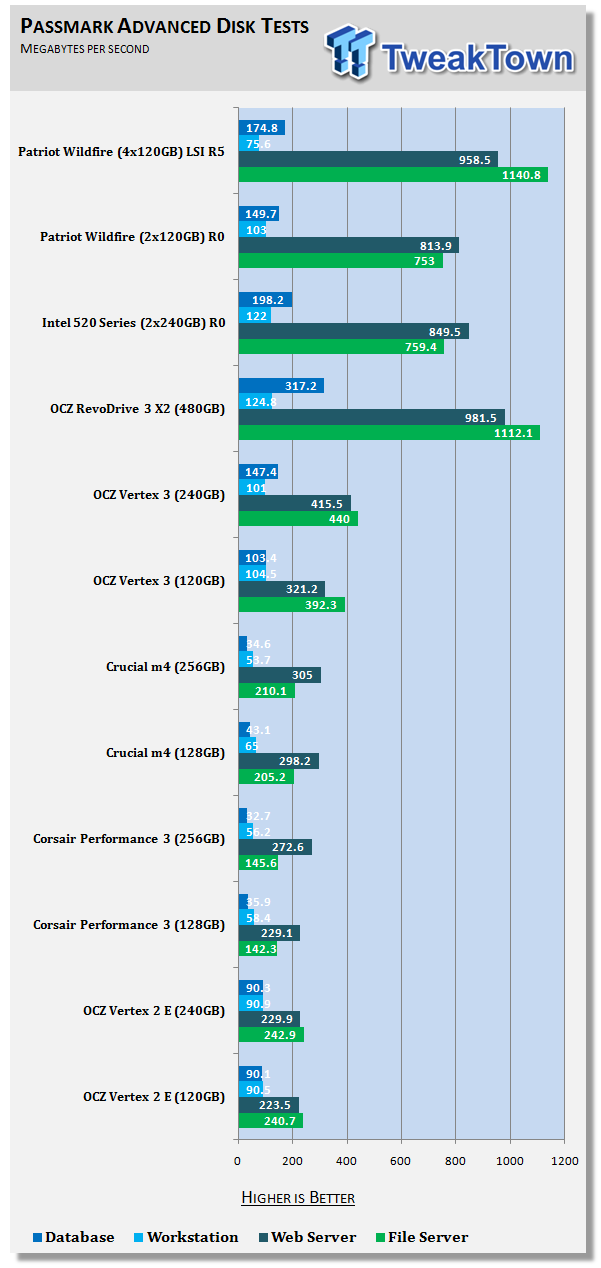
In the enterprise tests we see why the LSI 9265-8i is so popular with datacenters. Not only is the LSI card running redundantly it is also outperforming the two drive RAID 0 array on the Intel PCH RAID.
Final Thoughts
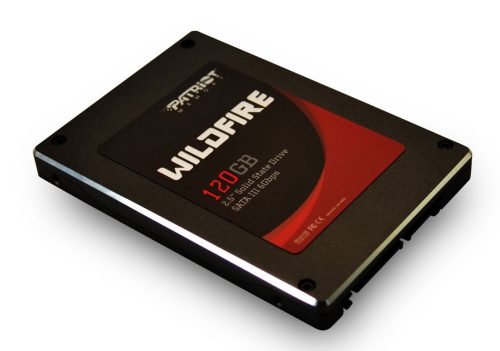
If this article looks familiar that is because it is, somewhat. We published our first RAID Report with the Patriot Wildfire back in June, just after the single drive review. A lot has changed with this and other SandForce drives since then. SandForce and their partners have done some amazing things with the firmware. All of the initial bugs have been cleared up and the performance has increased quite a bit in some areas as well. In this RAID Report we were also able to dive into the RAID 5 performance with four drives running on the LSI 9265-8i, the industry and enthusiast standard for RAID controllers at this time.
We've spent quite a bit of time with the Patriot Wildfire 120GB drives in RAID. This has been my platform for developing several new benchmarks based on real-world usage. Some of these benchmarks are game changers, much like the Drives with Data Testing. When these roll out it will change the way you think about some of the SSDs, or more specifically the controllers used today. We want to give a big shout out to Patriot for helping us out when we needed some specific drives for this sort of testing. Our consumer and new enterprise tests will benefit greatly from the knowledge we gained over the last couple of months.
Now for the analysis. The Patriot Wildfire has been a top performer ever since its launch in June 2011. That hasn't change, even with the new crop of super SSDs that are appearing now. Patriot choose wisely when they tapped into the performance of the Toshiba Toggle Mode flash. Drives like the SanDisk Extreme and Plextor M3 Series use new, faster 24nm Toggle Mode flash, but there are draw backs with both of these products. The big competitor is the Extreme, but we're still seeing instances where TRIM is not restoring the drive completely, an issue we've not had with the Wildfire or it's 32nm Toggle Mode flash.
The days are numbered for the Wildfire, though. Patriot has shown the new Wildfire SE with 24nm flash at Computex and we uncovered the information at CES back in January. We've heard from sources that even finding 32nm Toshiba Toggle Mode flash is difficult, a strong hint that the flash is now end of life. Given our experience with the new smaller die flash I think I'll stick with the 32nm Wildfire while I can still get it.
When it comes to pricing the Wildfire is now much cheaper than it was at launch. At $179.99 after a mail in rebate you would be hard pressed to find a faster drive for the money. Doubling up with RAID 0 on your build in native SATA 6G will deliver nearly 2x the performance of a single 240GB drive. Since we buy SSDs for their speed you might as well take as much of it as you can get.

 United
States: Find other tech and computer products like this
over at
United
States: Find other tech and computer products like this
over at  United
Kingdom: Find other tech and computer products like this
over at
United
Kingdom: Find other tech and computer products like this
over at  Australia:
Find other tech and computer products like this over at
Australia:
Find other tech and computer products like this over at  Canada:
Find other tech and computer products like this over at
Canada:
Find other tech and computer products like this over at  Deutschland:
Finde andere Technik- und Computerprodukte wie dieses auf
Deutschland:
Finde andere Technik- und Computerprodukte wie dieses auf